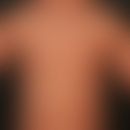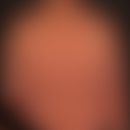Synonym(s)
HistoryThis section has been translated automatically.
DefinitionThis section has been translated automatically.
Group of genetically heterogeneous cornification disorders (Ichthys = fish) with mostly universal, abnormally dry and scaly skin. Palms and soles may also be affected. However, the palmoplantar keratoses do not ostensibly dominate the clinical picture.
For historical reasons, the cornification disorders are divided into:
- Ichthyoses affect the entire integument
- palmoplantar keratoses (palms and soles are mainly affected, extrapalmoplantar involvement is possible, but is less prominent in the clinical picture)
- Erythrokeratoderma (disseminated, clearly circumscribed keratoses accompanied or underlain by a distinct erythema).
Ichthyoses can be further divided into:
- syndromal ichthyoses (integument +other organs are affected)
- and
- non-syndromal ichthyoses (only the integument is affected).
In syndromal ichthyoses, the "ichthyosis" acts as a monitoring sign. It is important for clinical care on the one hand and for hereditary-clinical consultation on the other hand. In the meantime, almost all ichthyoses are genetically clarified.
Besides the genetic cornification disorders, acquired "ichthyosis-like" skin changes also occur(pseudoichthyoses), which can be triggered by a variety of underlying diseases or procedures: excessive washing procedures, malignancies (especially lymphomas), medications, renal insufficiency, infections (e.g. HIV), endocrinopathies (e.g. hypothyroidism). These reactive keratinization disorders can usually be classified by visual diagnosis and anamnesis.
You might also be interested in
ClassificationThis section has been translated automatically.
Non-syndromic ichthyoses (varies according to Oji 2018):
Common ichthyoses
- Ichthyosis vulgaris, autosomal (semi-)dominant (ADI - OMIM:146700; mutations in the filaggrin gene - FLG gene)
- X-linked recessive ichthyosis vulgaris (XRI - OMIM:308100; mutations in the steroid sulfatase gene - STS gene)
Autosomal recessive congenital ichthyosis (ACRI - former name: ichthyosis congenita group or congenital ichthyosis):
- Autosomal recessive congenital ichthyosis with mutation in TGM1 (see also swimsuit ichthyosis OMIM:242300 mutation in TGM1)
- Group of congenital autosomal recessive ichthyoses with mutations in various genes such as: ABCA12, ALOX12B, ALOXE3, CYP4F22; NIPAL4, LIPN, CERS3, PNPLA1, ST14, CASP14
- Harlequin ichthyosis (ichthyosis congenita gravis - mutation in ABCA12 - the encoded protein = lipid transporter).
- Self improving congenital ichthyosis (SICI - OMIM: 242300/242100/606545) - mutations in TGMI1/ALOX12B/ALOXE3)
- Ichthyosis-spastic quadriplegia-mental retardation (autosomal recessive ELOVL4 mutations with ichthyosis, seizures, mental retardation and spasticity)
Keratinopathic ichthyoses (KPI), also epidermolytic ichthyoses - mutations in keratin genes):
- Epidermolytic ichthyosis (older name: erythrodermia congenitalis ichthyosifomis bullosa Brocq) - mutation in KRT1/KRT10 gene
- Superficial epidermolytic ichthyosis (older name: Ichthyosis bullosa Siemens-OMIM: 146800, mutation in KRT2 gene)
Keratinopathic ichthyosis variants
- Annular epidermolytic ichthyosis (AEI-OMIM: 607602 mutation in KRT1/KRT10)
- Ichthyosis Curth-Macklin (ICM-OMIM:146950 mutation in KRT1
- Autosomal recessive epidermolytic ichthyosis (AREI-OMIM:113800 mutation in KRT10; variant of autosomal dominant epidermolytic ichthyosis)
- Congenital reticular ichthyosiform erythroderma (CRIE; confetti ichthyosis -OMIM:609165- mutation in KRT10/KRT1)
- Superficial epidermolytic ichthyosis (epidermolytic nevus) (OMIM 113800- somatic mutations in KRT1/KRT10/KRT2)
Other non-syndromic ichthyoses
- Loricrin keratoderma (LK - OMIM:604117; mutation in LOR)
- Erythrokeratodermia (figurata) variablis (EKV-OMIM: 133200 mutation in GJB3/GJB4)
- Peeling skin syndrome (PDS-OMIM: 270300 mutation in CDSN)
- Exfoliative ichthyosis (see below peeling skin syndrome type 4/5 - OMIM:607936/717115 mutation in CSTA/SERPINB8)
- Keratosis linearis-Ichthyosis congenita keratoderma (KLICK - OMIM: 601952; mutation in POMP)
- Autosomal recessive congenital ichthyosis with mutation in TGM1 (OMIM: 242300)
ClinicThis section has been translated automatically.
S.u. and the respective clinical picture.
HistologyThis section has been translated automatically.
Classification of ichthyoses according to their histological reaction pattern (var. according to D. Metze and H. Traupe 2016)
Orthohyperkeratosis with reduced or absent str. granulosum
- Ichthyosis vulgaris group (see above).
- Ichthyosis acquisita (acquired ichthoysis-like conditions)
- Refsum syndrome (+lipid vacuoles in basal keratinocytes)
- Dorfmann-Chanarin syndrome
- Trichothiodystrophy syndrome
- Conradi-Hünermann syndrome
- Harlequin ichthyosis (+massive hyperkeratosis, parakeratosis possible)
Orthohyperkeratosis with well developed str. granulosum
- Ichthyosis vulgaris, autosomal dominant (ADI)
- Ichthyosis vulgaris, X-linked recessive (XRI)
- Congenital atrichia
Orthohyperkeratosis with parakeratosis, normal or prominent str. granulosum
- Sjögren-Larsson syndrome (+church-tower-like eruptions)
- Erythrokeratoderma
- HID/KID syndrome
- Loricrin keratoderma
- KLICK syndrome
Epidermolytic hyperkeratosis
- Epidermolytic ichthyosis (ichthyosis Brocq)
- Anular epidermolytic ichthyosis
- Superficial epidermolytic ichthyosis (formerly: ichthyosis bullosa Siemens)
Epidermal keratinocytes binucleate with perinuclear vacuoles
- Congenital reticular ichthyosiform erythroderma (with parakeratosis)
- Ichthyosis Curth-Macklin (without parakeratosis)
Psoriasiform epidermal reaction
TherapyThis section has been translated automatically.
See below the respective clinical picture.
See below Ichthyoses, Therapy
TablesThis section has been translated automatically.
Therapeutic guidelines for frequent ichthyosis
Active ingredients |
ichthyosis vulgaris |
X-linked recessive ichthyosis |
Erythrodermia congenitalis ichthyosiformis non-bullosa |
Ichthyosis lamellosa |
Erythrodermia congenitalis ichthyosiformis bullosa |
ichthyosis bullosa |
|
Keratolytic measures |
Salicylic acid |
++ |
++ |
- |
+ |
- |
+ |
Urea |
+++ |
+++ |
+++ |
+++ |
+++ |
+++ |
|
| |||||||
Hydration |
Urea |
+++ |
+++ |
+++ |
++ |
+++ |
++ |
Lactic acid |
+++ |
+++ |
++ |
+ |
+ |
(++) |
|
| |||||||
Local retinoids |
Tretinoin |
(+) |
++ |
- |
+ |
- |
+/- |
Isotretinoin |
- |
- |
- |
++ |
- |
+/- |
|
| |||||||
Systemic retinoids |
Acitretin |
(+) |
++ |
(++) |
+++ |
++ |
++ |
LiteratureThis section has been translated automatically.
- Buxman M et al. (1986) Therapeutic activity of lactate 12% lotion in the treatment on ichthyosis. Active versus vehicle and active versus a petrolatum cream. J Am Acad Dermatol 15: 1253-1258
- DiGiovanna JJ, Robinson-Bostom L (2003) Ichthyosis: etiology, diagnosis, and management. Am J Clin Dermatol 4: 81-95
- Dumenigo A et al. (2022) CYP4F22-Related Autosomal Recessive Congenital Ichthyosis: Clinical Presentation. Cureus 14:e22272.
- Lorry AC (1777) Tractatus de morbis cutaneis. P. Guillelmum Cavelier, Paris, pp. 167-184
- Metze H et al (2016) Hereditary keratinization disorders and epidermal malformations. In: Cerroni L et al. Histopathology of the skin. Springer-Verlag Berlin Heidelberg p.407
- Niemi KM et al (1991) Recessive ichthyosis congenita type II. Arch Dermatol Res 283: 211-218
- Oji V(2018) Ichthyoses. In: Braun-Falco`s Dermatology, Venereology Allergology G. Plewig et al. (Eds.) Springer Verlag S 1066-1067
- Oji V et al. (2010) Revised nomenclature and classification of inherited ichthyoses: results of the First Ichthyosis Consensus Conference in Sorèze 2009. J Am Acad Dermatol 63: 607-641.
- Swanbeck G (1989) Urea as a monotherapeutic agent for dry skin. Dermatologist 40: 42-43
- Thauvin-Robinet C et al. (2005) X-linked recessive ichthyosis in a girl: strategy for identifying the causal mechanism. Br J Dermatol 152: 191-193
- Vincent QJI, Traupe H (2006) Ichthyoses: Differential diagnosis and molecular genetics. Eur J Dermatol 16: 349-359
- Willan R (1808) Ichthyosis. In: On cutaneous disease. Barnard, London, Vol.1, Chapter 4
Incoming links (43)
Acanthosis; Acitretin; Acrodermatitis enteropathica; ALOXE3 Gene; Anhidrotic ectodermal dysplasia; Brine bath; Chondrodysplasia calcificans congenita; Collodion baby; Comel-netherton syndrome; CYP4F22 Gene; ... Show allOutgoing links (53)
ABCA12 Gene; ALOX12B Gene; ALOXE3 Gene; Anular epidermolytic ichthyosis; Atrichia congenita with horny cysts; Autosomal recessive congenital ichthyosis; Autosomal recessive congenital ichthyosis with mutation in TGM1 ; Bathing suit ichthyosis; CASP14 Gene ; CDSN Gene; ... Show allDisclaimer
Please ask your physician for a reliable diagnosis. This website is only meant as a reference.









